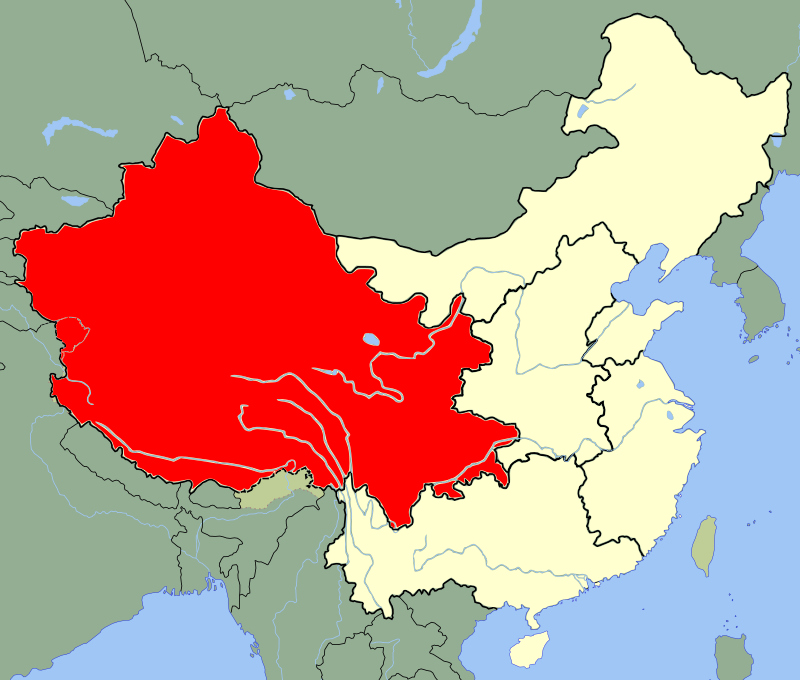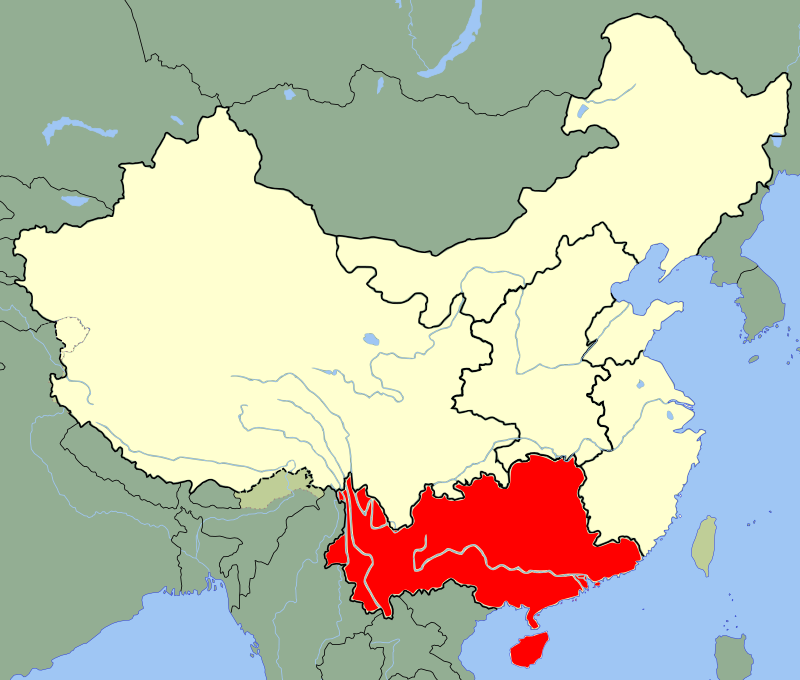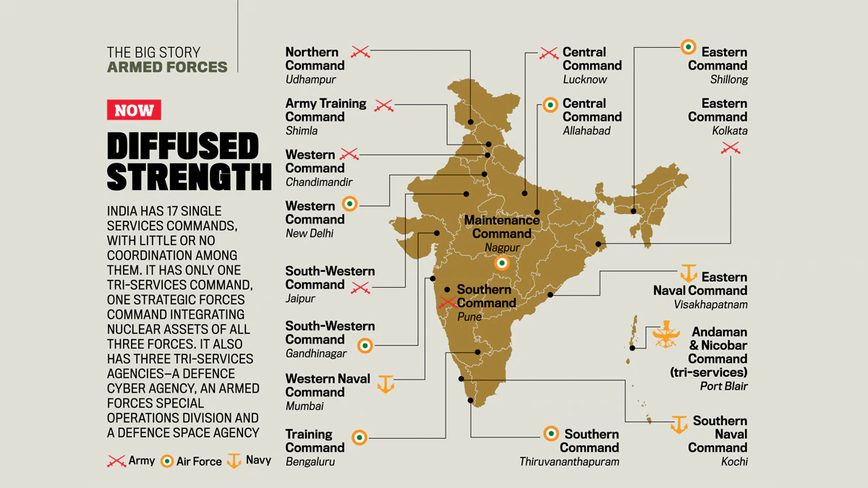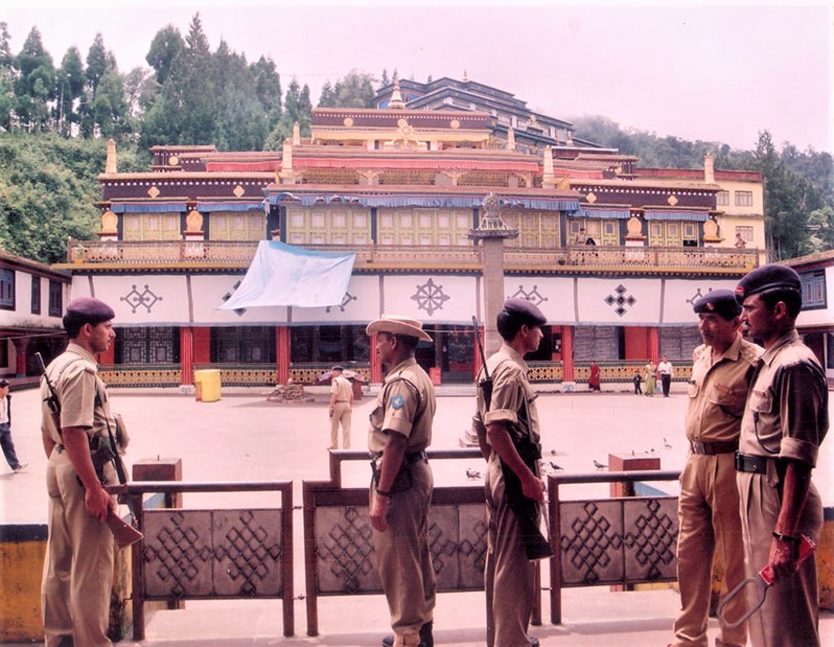
The Indian Armed Forces consists of professional uniformed services (army, navy, and air force) supported by three main paramilitary organisations: Indian Coast Guard, Assam Rifles and Special Frontier Force. With nearly 1.5 million soldiers, it is the world’s largest volunteer army. It is not the Prime Minister, but the President of India who is the supreme commander of her armed forces. Besides these forces controlled by the Ministry of Defence, the Ministry of Home Affairs heads the Central Armed Police Forces.
Although today perceived as a non-violent country thanks to the politics developed by Gandhi, India has in fact one of the most ancient military histories, dating back several millennia. It is not by chance that one of the two upper castes (varna) or social orders, of the Hindu society, is the one of the warriors: the Kshatriyas, who were traditionally the rulers in ancient times.
In the Ramayana and Mahabarata epics, most deities of the Hindu pantheon are armed with their own personal weapon, and are revered not only as martial experts but also as originators of those systems themselves. The strategic treatises like the Arthashâstra of Kautilya (Maurya dynasty), the Shastrashastra and the immemorial martial arts traditions (known as: yuddhakalā, āyudhavidyā, viravidyā) includes archery (dhanurveda – a section found in the Vedas (1700-1100 BC), wrestling (maladwandwa) and self defense (svarakshākalā) of which the Kalaripayattu of Kerala and the Silambam of Tamil Nadu are the most famous. Interestingly, some hagiographic references trace the origin of the Chinese martial art Kung Fu back to Kalaripayattu, through the Pallava Buddhist prince Bodhidharma who is said to have travelled to China and reached the Shaolin temple. More recently, the Sikh warriors’ sagas and their sword martial arts (shastra-vidya), as well as the Rajput princes’ epics showed that the Indian combat spirit was still vivid, at least until the British take-over.
There is no doubt that for thousands of years warfare has been an essential part of Hindu wisdom and more generally of the spiritual traditions of India. Although India’s deep-rooted culture is not only a non-violent one, almost 400 years of colonial domination (since the arrival of the Portuguese Vasco de Gama), not counting the waves of Jihad since the 8th Century, has considerably weakened the fighting spirit of the Indian nation.
Very quickly after independence and starting under the guidance of an undetermined Nehru, the new Republic of India was confronted with four major conflicts: the First Kashmir "Indo-Pak" War (Indian victory, 1947); “Operation Polo”, the annexation of Hyderabad State (Indian victory, 1948); the annexation of Goa “Operation Viyjay” (Indian victory, 1961); the Sino-Indian war (Chinese victory, 1962). Then after Nehru's death came the Second Indo-Pak war (Indian victory, 1965) and the second Indo-Sino Conflict, “Cho La & Nathula incidents” in Sikkim (Indian victory, 1967). The Third Indo-Pak war (Indian victory, 1971) led to the creation of Bangladesh. The Siachen War (Indian victory, 1984) established control over all of the 70 km long Siachen Glacier and its tributaries, and the Kargil war (Indian victory, 1999) was decisive over Pakistan. Out of these main conflicts, it was only against Chinese troops in the Himalayan border war of 1962 that India was defeated, although China decided to withdraw on its own accord.
The state of war between China and India has never been fully settled by any peace treaty since 1962, although an informal agreement called “confidence-building measures” (CBM) was agreed in 1996 over the so-called “Line of Actual Control”. It concerns the sovereignty over territories located on the furthest north western and the far-eastern parts of India. Aksai Chin is the westernmost territory claimed by India as part of the state of Jammu and Kashmir and Ladakh. It is still controlled and administered as part of the Chinese autonomous region of Xinjiang. The other large disputed territory, the easternmost, is claimed by China as part of the Tibetan territories annexed by Mao Zedong in 1950, and now called Arunachal Pradesh (formerly referred to as the “North East Frontier Agency”, or NEFA). It lies south of the McMahon Line.
Since the short but traumatic war of 1962, even though the Indian troops were able to repulse the Chinese People’s Liberation Army (PLA) during the 1967 skirmish, China has never surrendered its claim that the region of Arunachal Pradesh as part of its own territory, and has constantly upgraded its military presence at the northern border of India. The massive conventional force modernisation that the PLA has undertaken together with a double-digit increase in its defence budget has intensified the existing conventional asymmetry between India and China. Also, China’s extensive modernisation of border infrastructure presents a particularly worrisome scenario for the Indian Army. A widespread road and railway network enables the rapid deployment and re-deployment of troops and logistics for the PLA. The modernisation of airstrips in the Himalayan region permits China to deploy air power more swiftly against India.
China has settled her borders with all her neighbours except India and Bhutan. Sitting smugly on 38,000 sq km of Indian Territory in Aksai Chin and 5,180 sq km of the Shaksgam Valley in Pakistan-occupied Kashmir (POK) gifted by Pakistan, China’s claims to 90,000 sq km of Arunachal Pradesh is not a mere deflection of the Tibet issue. It indicates her resolve to reach the warm waters of the Indian Ocean through as many land routes as possible. That is why the road and railway through Karakoram to Pakistan, transportation corridors through Myanmar and repeated intrusions in Bhutan; claiming Dolam Plateau (the last high ground overlooking the Siliguri Corridor) and renewed road construction between Zuri and Phuteogang Ridge that overlooks the disputed Charithang Valley. The threat is more serious when viewed in conjunction with the Maoists of Nepal (spawned with the blessings of Beijing) and their links with Maoists in India.
The decision to raise new conventional forces has thus come in the wake of a growing realisation in New Delhi of its steadily declining standard deterrence.
China continually cautions India that that it retains the option to initiate military hostilities. In 2013 a PRC-controlled Hong Kong publication famously published an article entitled "Six Wars China Is Sure to Fight In the Next 50 Years”, leading scholars to speculate its source was legitimate Chinese defence analysis. These six wars would all be irredentist: the reclamation of what China believes to be territories lost from the time Imperial China was defeated by the British in the 1840-42 Opium War.
The first of these wars which visualised is the Reunification of Taiwan, expected to be fought between 2020-25. Later, between 2035-40 t visualised the re-conquest of "Southern Tibet" (i.e. Arunachal Pradesh), the main point of contention between China and India. The article suggested that “the best strategy for China is to incite the disintegration of India” by dividing it into several smaller countries so “India will have no power to cope with China.” The second best strategy, it explained, would be to assist Pakistan with weapon support in conquering Southern Kashmir, then "blitz" Arunachal Pradesh while India and Pakistan are busy fighting each other. With India unable to fight a two front war, it would likely lose both, allowing China to retake "Southern Tibet". In the worst case, direct military action to take back Southern Tibet would be necessary.
The PLA is the Hard Power of the PRC. The Chinese Armed Forces are modernising exponentially, upgrading systems, and introducing reforms, and modernising. China remains the largest among Armed Forces in the World. The PLA uses a system of "Theater Commands", of which there are five: Eastern (based in Nanjing), Southern (based in Guangzhou), Western (with headquarters in Chengdu), Northern operating from Shenyang, and Central (in Beijing). The purposes of the Theater Commands is to improve the coordination between military services (Army, Navy, Air, and Rocket Forces). For the purposes of our analysis, the Western and Southern Theatre Commands hold most relevance.

PLA Western Theatre Command
As we analyse in greater depth, China has not settled its border disputes with India, and aggressive military activity continues in the regions along the disputed border. The creation of peacetime joint theatre commands has significantly increased joint operations capabilities in the expansive Western Theater Command (WTC), which has responsibility for the Indian strategic direction
WTC covers challenging terrain such as desert and high mountains, long borders, and complex social conditions. Its responsibilities include supporting the People’s Armed Police Force maintaining stability in Tibet and Xinjiang, both highly restive areas. The Tibet Military Command/Military District in the WTC is placed under the PLA Army and is responsible for operations against India. It trains forces for specialised high-altitude mountain warfare and long-range mobility, for example in operations targeting Arunachal Pradesh in the east, one of the primary border areas under dispute, along with the Chinese-occupied Aksai Chin in the west.
There has been ongoing tension between the two countries over China's activity in these border regions as well as in the Indian Ocean. A role of the WTC would be to coordinate operations with the responsible command for naval operations against India. Infrastructure in the Sino-Indian border region such as roads and airstrips has been massively enhanced under China's development of Tibet, which also serves to prepare for defensive or offensive military operations.
The creation in peacetime of theater joint commands reduces the need for pre-war preparations, increases the combat effectiveness of forces, and provides for a rapid transition to wartime operations.
Read more:

PLA Western Theatre Command
Southern Theater Command (STC) covers an area almost double the size of Texas and a population (320 million) larger than that of the entire U.S. The Army, Navy and Air Force Theater Command Headquarters report to the STC. STC is responsible for China’s important borders with Myanmar and Vietnam and the vast area claimed by China in the South China Sea.
China’s activities in Myanmar concern its ambitions for better access to the sea via the Myanmar coast. China has been assiduously building up a ‘second coast’ in Myanmar overlooking the Bay of Bengal and the Andaman Sea. Given China’s plans to further link its provinces to markets in Southeast Asia and along the Indian Ocean via Yunnan, this area is likely to become an important transport corridor, raising the importance of PLA units stationed there.
As far as the maritime threat to India is concerned, the PLAN South Sea Fleet is likely to be placed under STC which would pose a threat to the Indian Ocean with further modernisation of the Chinese Navy. China’s ability to project power and deterrence along this strategic Southern axis will surely see a marked improvement. Accordingly, India has to deal with a continental threat from Western Command and a maritime threat from Southern Command.
Read more:
What does China face on the Indian side at present? Some signs of change are very much evident in India’s outlook towards its conventional deterrence.
The Indian forces protecting the northern border are dispatched in three main sectors: Eastern (Kolkata), Northern (Udhampur) and Western. Out of its 35 divisions, India already has 10 divisions dedicated to mountain warfare and another infantry division earmarked for high altitude operations.
Eastern Command is the largest of the Indian Army's six geographic operational commands, responsible for defending northeast and eastern India, including the strategic Siliguri corridor, from external or secessionist threats. It is headquartered in Fort William, the former seat and symbol of authority of the British Empire in Kolkata in West Bengal. The Command's present theatre extends from Bengal to Sikkim and then across the entirety of northeast India.
The Command is responsible for military operations along the international borders with Bangladesh, Bhutan, China, Myanmar and Nepal. The close proximity to these countries adds significance to its strategic geopolitical position and standing. Eastern Command bore the brunt during the Sino-Indian war of 1962.
The regiments within Eastern Command most relevant for the analysis of Himalayan issues and crises are:
The Northern Command is based in Udhampur, Jammu & Kashmir, and consists of three Corps, the XIV, XV, and XVI. Most units are deployed along the military Line of Control (LOC), the de facto border between the Indian and Pakistani controlled parts of Jammu & Kashmir. Troops of the Northern Command have been manning the "highest battlefield in the world" at Siachen.
Driven largely by China's military expansion and modernisation, as wells on threats at India’s borders with its neighbours such what happened with Bhutan during the 2017 Doklam crisis (see our geopolitical analysis of Bhutan), India is working on redesigning existing military commands into theatre commands. New joint commands will combine the resources and assets of its army, air force and navy in a particular under the operational control of three-star generals. India could have up to five theatre commands: even including an independent theatre command for Jammu & Kashmir. The Indian system is likely to be unique because few other countries face such vast disputed boundaries with nuclear-armed neighbours.



India-Tibet Border Police Force guarding the Rumtek Monastery in Sikkim
Additional to the standard military forces, there are three units of India's Central Armed Police Forces, security forces under the authority of Ministry of Home Affairs, whose role is to defend the national interest mainly against the internal threats. They are:
Read more:
This interactive map has been prepared by the Harvard Kennedy School of Government's Belfer Center for Science and International Affairs, as part of its March 2020 report "The Strategic Postures of China and India: A Visual Guide". The map can also be viewed here at Google Maps.
Airpower Across the Himalayas: A Military Appreciation of Chinese and Indian Air Forces, International Relations and Security Network (2013-12)
Bhutan: The Indian Army’s Front Line, The Diplomat (2014-11-06)
Xi Jinping Tightens Grip on Army, Ups Pressure on India, New Indian Express (2015-08-10)
GOC-in-C of Eastern Command reviews counter-insurgency operations in Assam, Economic Times (2015-10-29)
China’s Military Reforms Have Serious Implications, New Indian Express (2016-02-04)
China's Creeping Invasion of India, The Diplomat (2017-07-06)
Impact Of PLA: New Theatre Commands, Bharat Shakti (2017-08-5)
PLA Joint Exercises in Tibet: Implications for India, Observer Research Foundation (2020-02)
The Tough Road Ahead, India Today (2020-02-10)